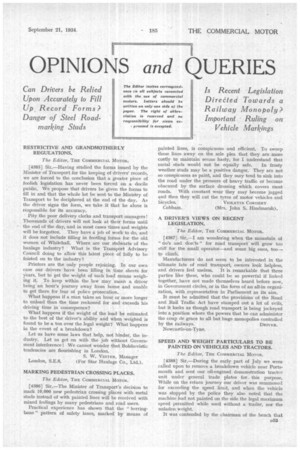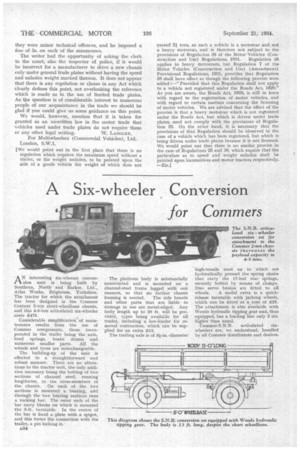OPINIONS and QUERIES
Page 111

Page 112

If you've noticed an error in this article please click here to report it so we can fix it.
RESTRICTIVE AND GRANDMOTHERLY REGULATIONS.
The Editor, THE COMMERCIAL MOTOR.
[4385] Sir,—Having studied the forms issued by the Minister of Transport for the keeping of drivers' records, we are forced to the conclusion that a greater piece of foolish legislation has never been forced on a docile public. We propose that drivers be given the forms to fill in and that the whole lot be sent to the Ministry of Transport to be deciphered at the end of the day. As the driver signs the form, we take it that he alone is responsible for its accuracy.
' Pity the poor delivery clerks and transport managers! Thousands of drivers will not look at their forms until the end of the day, and in most cases times and weights will be forgotten. They have a job of work to do, and it does not include filling in footling forms for the old women of Whitehall. Where are our stalwarts of the haulage industry? What is the Transport Advisory Council doing to alloW this latest piece of folly to be foisted on to the industry?
Printers are the only people rejoicing. In our own case our drivers have been filling in time sheets for years; but to get the weight of each load means weighing it. To keep within the law may mean a driver being an hour's journey away from home and unable to get there for fear of police prosecution.
What happens if a man takes an hour or more longer to unload than the time reckoned for and exceeds his driving time in consequence?
What happens if the weight of the load be estimated to. the best of the driver's ability and when weighed is found to be a ton over the legal weight? What happens in the event of a breakdown?
Let us have some laws that help, not hinder, the industry. Let us get on with the job without Government interference I We cannot wonder that Bolshevistic tendencies are flourishing in London.
S. W. VINTER, Manager London, S.E.8. (For Star Haulage Co., Ltd.).
MARKING PEDESTRIAN CROSSING PLACES.
The Editor, THE COMMERCIAL MOTOR.
[4386] Sir,—The Minister of Transport's decision to mark 10,000 new pedestrian crossing places with metal studs instead of with painted lines will be received with mixed feelings by many pedestrians and road users.
Practical experience has shown that the " herringbone " pattern of safety lanes, marked by means of painted lines, is conspicuous and efficient. To sweep these lines away on the sole plea that they are more costly to maintain seems hasty, for I understand that metal studs would not be equally safe. In frosty weather studs may be a positive danger. They are not so conspicuous as paint, and they may tend to sink into the road under the pressure of heavy traffic or become obscured by the surface dressing which covers most roads. With constant wear they may become jagged and then they will cut the tyres of motor vehicles and
bicycles. VIOLETTE CORDERY.
Cobham. (Mrs. John S. Hindmarsh).
A DRIVER'S VIEWS ON RECENT LEGISLATION.
The Editor, THE COMMERCIAL MOTOR.
[4387] Sir,---I am wondering when the mountain of "do's and don'ts" for road transport will grow too stiff for the small operator—and some big ones, too— to climb.
Manufacturers do not seem to be interested in the ultimate fate of road transport, owners look helpless, and drivers feel useless. It is remarkable that three parties like these, who could be so powerful if linked together, have not made themselves heard before now, in Government circles, or in the form of an all-in organization, with representation in Parliament as its aim.
It must be admitted that the provisions of the Road and Rail Traffic Act have stamped out a lot of evils, but it looks as though road transport is being jockeyed into a position where the powers that be can administer the coup de grace to all but huge monopolies controlled by the railways. DRIVER. Newcastle-on-Tyne.
SPEED AND WEIGHT PARTICULARS TO BE PAINTED ON VEHICLES AND TRACTORS.
The Editor, ME COMMERCIAL MOTOR.
[4388] Sir,—During the early part of July we were called upon to remove a breakdown vehicle near Portsmouth and sent our oil-engined demonstration tractor unit under general trade plates for-. this purpose. While on the return journey our driver was summoned for exceeding the seed limit, and when the vehicle was stopped by the police they also noted that the machine had not painted on the side the legal maximum speed permitted while used without a trailer, nor the unladen weight.
It was contended by the chairman of the bench that n53 they were minor technical offences, and he imposed a tine of 5s. on each• of the summonses.
The writer had the opportunity of asking the clerk to the court, also the inspector of police, if it would be incorrect for a manufacturer to drive a new chassis only under general trade plates without having the speed and unladen weight marked thereon. It does not appear that there is any regulation or clause in any Act which clearly defines this point, not overlooking the reference which is made as to the use of limited trade plates. As the question is of considerable interest to numerous people of our acquaintance in the trade we should be glad if you could give us some guidance on this point.
We would, however, mention that it is taken for granted as an unwritten law in the motor trade that vehicles used under trade plates do not require these
or any other legal writing. W. LANGLEY, For Multiwheelers (Commercial Vehicles), Ltd. London, S.W.1.
[We would point out in the first place that there is no regulation which requires the maximum speed without a trailer, or the weight unladen, to be painted upon the side of a goods vehicle the weight of which does not exceed 21 tons, as such a vehicle is a motorcar and not a heavy motorcar, and is therefore not subject to the provisions of Regulation 38 of the Motor 'Vehicles (Con struction and Use) Regulations, 1931. Regulation 38 applies to heavy motorcars, but Regulation 7 of the ' Motor Vehicles (Construction and Use) (Amendment) Provisional Regulations, 1931, provides that Regulation 38 shall have effect as though the following provisei were added:—" Provided that this Regulation shall not apply to a vehicle not registered under the Roads Act, 1920." As you are aware, the Roads Act, 1920, is still in force with regard to the registration of motor vehicles, and with regard to certain matters concerning the licensing of motor vehicles,. We are advised that the effect of the proviso is that a heavy motorcar which is not registered under the Roads Act, but which is driven under trade plates, need not comply with the provisions of Regulation 38. On the other hand, it is necessary that the provisions of that Regulation should be observed in the case of a vehicle which has been registered, but which is being driven under trade plates because it is not licensed. We would point out that there is no similar proviso in the case of Regulations 25 and 30, which require that the particulars as to speed and weight unladen shall be painted upon locomotives and motor tractors respectively.








































































































































































